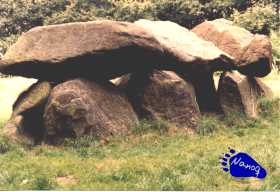 Post
kelkaj metroj maldekstraflanke ĉe la strato sur herbejo staras la tombeto.
Post
kelkaj metroj maldekstraflanke ĉe la strato sur herbejo staras la tombeto.Nederlando Niederlande
Netherlands
Eŭropo Europa Europe
Index
Malgranda kaj bele konservita granddolmeno. Ĝi konsistas de tri kapŝtonoj, ses flankŝtonoj kaj du finŝtonoj. Ĝi longas 5,5 m kaj etas 3,1 m larĝa. Laŭ la konkludoj de Prof-ro Van Giffen troviĝis en la ĉirkaŭejo eble kvar pluaj dolmenoj. Li trovis multon de artaĵoj kiuj hodiaŭ estas videblaj en la Drenta Muzeo en Assen.
La
tombo estas atingebla venante de Tynaarlo kaj krucante la fervojo.  Post
kelkaj metroj maldekstraflanke ĉe la strato sur herbejo staras la tombeto.
Post
kelkaj metroj maldekstraflanke ĉe la strato sur herbejo staras la tombeto.
Kleiner
und gut konservierter Großdolmen. Er besteht aus drei Decksteinen, sechs
Trag- und zwei Schlußsteinen. Er ist 5,5 m lang und 3,1 m breit. Laut
den Ergebnissen von Untersuchungen durch Prof. 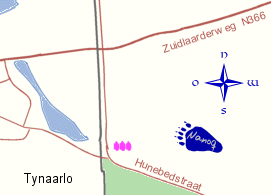 Van
Giffen gab es in der Umgebung vier weitere Megalithgräber. Ferner hat er
dabei eine Anzahl Kunstgegenstände ausgegraben.
Van
Giffen gab es in der Umgebung vier weitere Megalithgräber. Ferner hat er
dabei eine Anzahl Kunstgegenstände ausgegraben.
Das Grab ist leicht zu erreichen, wenn man von Tynaarloo kommt, nach dem Ortsausgang dieEisenbahnlinie überquert. Nach einigen Metern findet man das Grabmonument auf einer kleinen Wiese am linken Straßenrand.
A small and well-preserved gallery grave. It consists of three capstones, six sidestones and two endstones. The grave is 5.5 m long and 3.1 m wide. According to the results of Prof. Van Giffen, there were once four more dolmens in the neighbourhood. He found a large number of artifacts in the tomb.
The tomb is easily to reach, comming from Tynaarloo and crossing the railroad. After some meters you find the tomb on a lawn at the left side of the road.
La
du portalecaj tomboj D3 kaj D4 troviĝas en la komunumo Zuidlaren [Zojdlaren]
sur privata bieno en la vilaĝo Midlaren. Unuafoje menciataj estis tiuj
du tomboj en la jaro 1711 de S-ro L. Smids. Li kredis ke ili estus unu
tombmonumento. 1870 oni forigis la kovron kaj serĉfosis en la ĉambro.
Parto 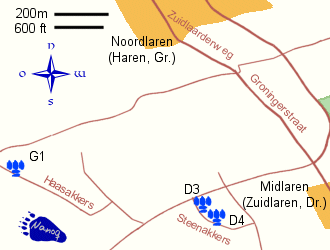 de la trovaĵoj elfosigataj nun troviĝas en la Drentha museo
de Assen, en la Reĝa Muzeo (Rijksmuseum [rajksmuseum]) de Amsterdamo
kaj la Brita Muzeo de Londono. D3 ankoraŭ ne estas profunde eksamenita
kaj ankaŭ ne restaŭrita.
de la trovaĵoj elfosigataj nun troviĝas en la Drentha museo
de Assen, en la Reĝa Muzeo (Rijksmuseum [rajksmuseum]) de Amsterdamo
kaj la Brita Muzeo de Londono. D3 ankoraŭ ne estas profunde eksamenita
kaj ankaŭ ne restaŭrita.
D3 longas 10,7m kaj larĝas 4,4m kaj konsistas el 12 flankŝtonoj sub 6 kapŝtonoj. La eniro konsistas de unu paro de flankŝtonoj. Hodiaŭ mankas siaj kapŝtonoj. La tombo estas orientita al 86°30′ Or-Ok.
D4 longas 14,8 m, larĝas 3,9 m kaj konsistas el 14 flankŝtonoj sub 7 kapŝtonoj, ambaŭ finŝtonoj kaj unu paro de portŝtonoj. La ĉambro estas orientita al 91°30′ N-S.
La tomboj troviĝas okcidente de Midlaren. Forlasinte la vilaĝon oni atingas post mallonge malnovan bienon. Eta vojo gvidas inter heĝojn al la tombojn. Ekzistas ankaŭ malgranda gvidilo.
Die beiden Portalgräber D3 und D4 befinden sich in der Gemeinde Zuidlaren auf einem privaten Bauernhof in der Ortschaft Midlaren. Erstma ls erwähnt wurden die Gräber 1711 von L. Smids. Er glabute, daß die sie ein Grabmonument bildeten. 1870 wurden die Deckhügel entfernt, und man grub auch in der Grabkammer. Ein Teil der Funde, die dabei ausgegraben wurden, befindet sich nun im Drenths Museum von Assen, im Rijksmuseum van Oudheden von Leiden und im British Museum von London. D3 wurde noch nicht so intensiv untersucht und es ist auch bislang nicht restauriert worden.
D3 ist 10,7 m lang und 4,4 m breit und besteht aus 12 Trag- und 6 Decksteinen. Der Eingang besteht aus einem Paar Tragsteinen. Seine Decksteine fehlen. Das Grab ist nach 86°30′ W-O ausgerichtet.
D4 ist 14,8 m lang, 3,9 m breit und besteht aus 14 Trag- und 7 Decksteinen, sowie einem Paar Portalsteinen. Die Kammer ist nach 91°30′ N-S ausgerichtet.
Die Gräber liegen westlich von Midlaren. Wenn man den Ort verläßt, erreicht man nach einiger Zeit einen alten Bauernhof. Dort führt ein kleiner Pfad zwischen Hecken zu den Gräbern. Es gibt auch einen kleinen Wegweiser.
The two passage graves D3 and D4 are found in the municipality of Zuidlaren on a private farm in the village of Midlaren. They were mentioned for the first time in 1711 by L. Smids. He thought that they were a big grave-monument. In 1870 the covers were removed and excavations were done in the chamber. Part of the finds can be seen in the Museum of Drenthe in Assen, in the Royal museum of antiquities in Leiden and in the British Museum of London. D3 is not examined yet and is still not being restored.
D3 is 10.7 m long and 4.4 m wide and consists of 12 sidestones and 6 capstones. The entrance consists of one pair of sidestones. The capstone has been removed. The grave is oriented to 86°30′ W-E.
D4 is 14.8 m long, 3.9 m wide and consists of 14 sidestones and 7 capstones and one pair of sidestones of the entrace. Also here the capstone is missing. The chamber is oriented to 91°30′ N-S.
The graves can be found west of Midlaren. Some time after leaving the village you reach an old farmhouse. There, between some hedges, a small way leads you to the graves just behind the hedges. There is also a small arrow showing the way.
Galerieca tombo kiu konsistas de kvar kapŝtonoj kaj kvar paroj de flankŝtonoj. Ankaŭ ambaŭ finŝtonoj ne mankas. Ĝi longas 7,4 m kaj larĝas 2,5 m. Tiu tombo unuafoje estis menciata en la jaro 1833 de C.J.C. Reuvens. Ĝis hodiaŭ la tombo ne estas plene elfosigita, pro tio ĝi kuŝas malkutime en trueto.
Ĝi estas atingebla forlasante la vilaĝon Zeijen norden. Post aŭtoparkejo vi trovas vojmontrilon.
Galeriegrab,
das aus vier Jochen und zwei Schlußsteinen besteht. Es ist 7,4 m lang
und 2,5 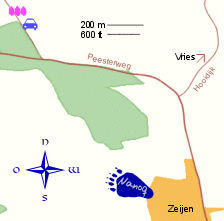 m breit.
Dieses Grab wurde erstmals 1833 von C.J.C. Reuvens erwähnt und ist bislang
nicht ganz ausgegraben, wodurch es etwas ungewöhnlich in einer Mulde liegt.
m breit.
Dieses Grab wurde erstmals 1833 von C.J.C. Reuvens erwähnt und ist bislang
nicht ganz ausgegraben, wodurch es etwas ungewöhnlich in einer Mulde liegt.
Es ist leicht zu erreichen, wenn man Richtung Norden Zeijen verläßt. Nach einigen Metern erreicht man einen Parkplatz mit einem Wegweiser.
Gallery grave which consists of four capstones and two endstones. It is 7.4 m long and 2.5 m wide. This grave was first mentioned in 1833 by C.J.C. Reuvens and up-to-now is not completely excavated. That is why it lies somewhat unusually in a sand-hole. It can be easily reached if you leave Zeijen to the north. After some time you find a parking area and there a sign shows you the way.
Preskaŭ plena portaleca tombo de griza granito kiu konsistas el ses paroj de flankŝtonoj, ses kapŝtonoj kaj du finŝtonoj. Ankaŭ La eniro konsistas el du paroj flankŝtonoj kaj unu de du kapŝtonoj ankoraŭ ĉeestas. Ĝi estis konstruata ĉirkaŭ 2000 a.n.t. La ĉambreto longas 11,6 m, larĝas 3,6 m kaj montras al 98° Or-en, la enirejo montras al 175° S.
Unuafoje menciata estis tiu tombo 1811 en vojaĝrakonto de S-ro N. Westendorp. Kiam ĝi estis trovata en la jaro 1918 ĝi estis ruino. La rompitaj ŝtonoj estis kunigotaj de S-ro Van Giffen kaj remetotaj en sia oriĝinala stato. Tamen pli profundaj esploroj ankoraŭ ne estas verigitaj.
La tombo estas atingebla de la centro de Roden sur la Norgerweg direkte Roderesch, Norg. De tie dekstren direkte Roderesch, Steenbergen, Een. Sur la ĉefstrato tra la arbaro kontinuu kaj ĉe la ŝanĝo de la arbaro al kampo enturnu la sabla vojon. Post kelkaj metroj vi trovos la tombon rektaflanke.
Alia ebleco estas venante de Norg. De la centro la vojo iras direkte Roden, Langelo. De la strato Langeloërweg-Norgerweg. De tie sekvu la vojgvidilon maldekstren: Steenbergen. Turnu dekstren de la ĉefstrato. Rekte ĉe la arbarbordo troviĝas la tombo rektaflanke ĉe sablovojo kiu elturnas maldekstren
Fast vollständiges Portalgrab aus grauem Granit, das aus sechs Jochen und je einem Schlußstein an jeder Stirnseite besteht. Auch der Eingang aus zwei Paaren Tragsteinen und einem von zwei Portaldecksteinen ist vorhanden. Es wurde etwa 2000 J.v.u.Z. errichtet. Die Grabkammer ist 11,6 m lang, 3,6 m breit. und in O-W Richtung 98°ausgerichtet, der Eingang zeigt nach 175°S.
Erstmals erwähnt wurde es 1811 in einer Reiseerzählung von N. Westendorp. Als es 1918 entdeckt wurde, war es eine Ruine. Die zerbrochenen Steine wurden wieder durch Dr. Van Giffen zusammengefügt und das Grab wieder in den Originalzustand gesetzt. Nähere Untersuchungen wurden jedoch bislang nicht vorgenommen.
Erreichbar
ist das Grab vom Zentrum von Roden auf dem Norgerweg in
Richtung Roderesch, Norg. Von dort rechts abbiegen 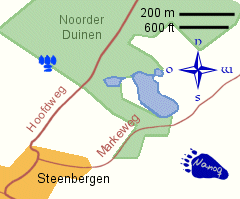 in
Richtung Roderesch, Steenbergen, Een. Auf der Hauptstraße
durch den Wald weiter und wo der Wald in in Ackerland übergeht liegt das
Grab am Sandweg, der nach rechts abgeht.
in
Richtung Roderesch, Steenbergen, Een. Auf der Hauptstraße
durch den Wald weiter und wo der Wald in in Ackerland übergeht liegt das
Grab am Sandweg, der nach rechts abgeht.
Eine andere Möglichkeit bietet sich in Norg. Vom Zentrum
führt der Weg in Richtung Roden, Langelo über
den Langeloërweg-Norgerweg. Von dort folge man dem Wegweiser nach links:
Steenbergen. An der Hauptstraße rechts abbiegen. Dierekt am Waldrand
liegt das Grab am Sandweg, der nach links abgeht.
Nearly complete portalgrave of grey granite, which consists of six yokes and one endstone at each side. Also the entrance of two pairs of sidestones and one from formerly two capstones is still present.It was erected round 2000 b.C. The funeral chamber is 11.6 m long and 3.6 m wide and is oriented to 98° E-W; the entrance points to 175°S.
It was first mentioned in 1811 in a report by N. Westendorp. When discovered in 1918 it was ruined. The broken stones were set together by Dr. Van Giffen and the grave was set into its original state. However, further examinations or excavations have not yet been done.
You can reach the tomb coming from Roden via Norgerweg-street in the direction of Roderesch, Norg. From there, turn right in the direction of Roderesch, Steenbergen, Een. Continue on the main road through the forest. Where the forest turns into agricultural land, take the sandy way which turns to the right. There, after some meters, you find the grave on the right. Another possibility is to come from Norg. From the centre the way goes in the direction of Roden, Langelo via Langeloerweg-Norgerweg-street. From there, follow the small blue sign to the left: Steenberen. At the main road turn right. Just at the edge of the forest you find the grave by taking the sandy way to the left.
Damaĝita koridora tombo kiu oriĝinale konsistis de kvar jukoj kaj dujuka enirejo. Du kapŝtonoj kuŝas sur siaj flankŝtonoj, unu kuŝas inter ili kaj la kvara estas malaperigita, kiel ankaŭ ambaŭ kapŝtonoj de la enirejo. La tombo longas 8 metroj kaj larĝas 3 m, la enirejo orientiĝas al 97°S. Ĝi estis menciita unuafoje en 1869. La fondo ĝis nun ne estas esplorita, nur restaŭrigajn laborojn oni jam plenumigis.
Beschädigtes
Ganggrab, das einst aus vier Jochen und einem zweijochigem Eingang bestand.
Zwei Decksteine liegen auf ihren Tragsteinen,  einer
liegt beschädigt dazwischen, der vierte ist verschwunden, so wie auch die
beiden Decksteine des Eingangs, von dem nur die vier Tragsteine noch vorhanden
sind. Es ist 8 m lang und 3 m breit, der Eingang ist nach 97°S ausgerichtet.
Es wurde erstmals 1869 erwähnt. Der Untergrund ist bislang nicht untersucht
worden, lediglich Restaurierungsarbeiten hat man mehrmals durchgeführt.
einer
liegt beschädigt dazwischen, der vierte ist verschwunden, so wie auch die
beiden Decksteine des Eingangs, von dem nur die vier Tragsteine noch vorhanden
sind. Es ist 8 m lang und 3 m breit, der Eingang ist nach 97°S ausgerichtet.
Es wurde erstmals 1869 erwähnt. Der Untergrund ist bislang nicht untersucht
worden, lediglich Restaurierungsarbeiten hat man mehrmals durchgeführt.
Damaged passage grave, which originally consisted of four yokes and an entrance of two yokes. Two capstones lie on their sidestones, a broken one between them. The fourth has disappeared, like both capstones of the entrance, of which only the four sidestones are still present. The grave is 8 m long and 3 m large, the entrance is orientated to 97°S. It was first mentioned in 1869. The ground has not been examined yet, only several restorations have been done.